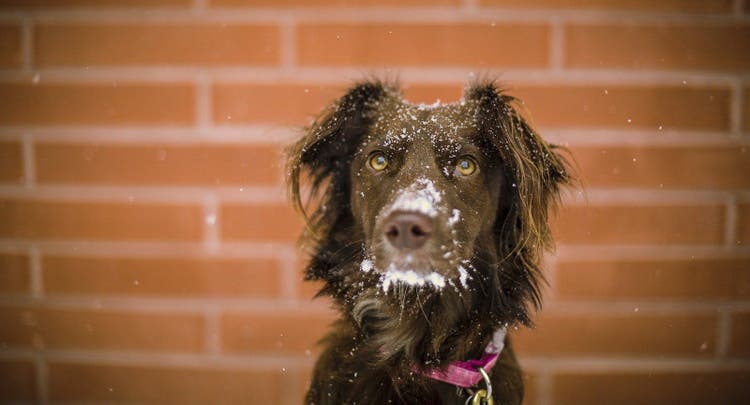
Temperature and Your Dog
Most people know that leaving a dog unattended in a car is very unsafe, but those same pet owners might not understand the danger that indoor and outdoor temperatures can have on their pets. Whether your dog lives fully indoors, partially inside and outside, or fully outside; the temperatures present in your pet’s environment play a large role in your dog’s health.
Cold
Unsurprisingly, certain dogs are more affected by the cold than others, particularly older dogs or those with health ailments, like arthritis. Be sure you have the right breed for your particular climate. You can start off by picking a breed made for bitter winters, especially if you live in colder climates and expect to be outside with your dog for a significant amount of time.
Most, but not all, larger breeds are well suited for colder climates. Body fat plays an essential role in helping your dog regulate its internal temperature. Additionally, dogs are able to regulate their temperature through their feet and tongues. This means that protecting your dog’s pads are very sensitive to cold and hot temperatures. Wearing booties in the winter can help to prevent your dog from losing important body heat due to snow or wet conditions on the ground.
Dogs that are well suited for cold climates include:
- Alaskan Malamutes
- Siberian Huskies
- Chow Chows
- St. Bernards
- Great Pyrenees
- Samoyed
- Bernese Mountain Dogs
- Newfoundlands
- Akitas
- American Eskimo Dogs
The types of dogs that typically don’t do well in the cold have little to no body fat or fur. These dogs don’t have the insulation they need to keep themselves warm when temperatures drop. These dogs will need help to stay warm in the winter, including jackets, boots, and a heated bed or two. Most small dogs will need some level of protection from the cold, but the dogs listed below need extra special assistance when it comes to chilly temperatures.
Dogs that are not well suited for cold climates include:
- Greyhounds
- Whippets
- Italian Greyhounds
- Chihuahuas
- Toy Poodles
- Pharaoh Hounds
- Basenjis
- Chinese Cresteds
- Salukis
- Ibizan Hounds
The outdoors are not the only environments in which your dog could be exposed to below optimal temperatures. If you leave your pet indoors all day, you’ll need to monitor the temperatures in your house so that your pet will be happy and healthy while you’re away.
Normal body temperature for dogs is 100.5 to 102.5 degrees Fahrenheit. Dogs can start suffering from the cold after temperatures dip it 45º. If you’re planning on saving energy by shutting off your heat when you’re away from home in the winter, you’ll need to reconsider for the sake of your pet. We recommend that you keep your home at least 50º during the day and night and keep warm bedding accessible for your dog to use. If you notice that your dog starts exhibiting any of the following signs it could mean that they are suffering from the cold temperatures. Give your vet a call if you’re concerned about your pet’s health during the upcoming cold months.
- Acting anxious
- Shivering
- Whining
- Moving at a slower pace
- Hiding out in warmer locations
Hot
So now that you’re aware that your dog needs to be protected against the cold while indoors and out, you’re probably prepared to blast the heat all day while you’re away at work to keep your pet safe and happy. It might surprise you to hear that large breed can start to be affected by heat at temperatures as moderate as 70º. Heat-related illnesses can include heat stroke, heat exhaustion, heat cramps, dry skin, and dehydration. All of these illnesses can occur in all dogs, and all can be prevented by taking adequate precautions.
Dogs that are well suited for hot climates include:
- Beagle
- Schnauzer
- Parson Russell Terrier
- Greyhound
- Australian Cattle Dog
- Border Collie
- Vizsla
- Miniature Pinscher
- Weimaraner
- Doberman Pinscher
- Dalmatian
- Cairn Terrier
- Chihuahua
- Whippet
- Italian Greyhound
A lot of different factors play into how a dog will be affected by heat such as hair coat, facial conformations, and size. Preexisting health factors will also play a large role. Dogs with thick, heavy, double hair coats, such as chows and alaskan malamutes, easily overheat. Without periodic shaving, these dogs tend to retain body heat and can struggle through the hottest times of the day. Panting is one method used by dogs to eliminate excess body heat. Dog breeds with short noses and pushed-in faces, such as english bulldogs, pugs, pekingese, and boxers, tend to have a more difficult time in hot weather or hot environments. Giant breed dogs, such as Newfoundlands and St. Bernard’s, cannot handle exercise in hot weather as well as smaller dogs. This results in sluggishness. Without appropriate exercise, these dogs are prone to obesity.
Keep Your Pet Safe This Winter With PetPlace
Keep your pet safe by following the above tips for keeping your home temperature well adjusted this winter. Whether your furry friend is big or small, you can give them the environment they need to thrive easily. If you have any questions about what’s too hot or too cold for your pet shoot us a message down below or browse any of our other thousands of vet-approved articles.